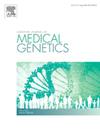新型 KDM5C 变体纠正了之前的错误诊断。
IF 1.7
4区 医学
Q3 GENETICS & HEREDITY
引用次数: 0
摘要
二十多年前,一名初产妇因担心影响其三个兄弟的不良表型复发而前来就诊。三兄弟都有智力障碍、发育迟缓、行为问题和畸形特征。当时可用的筛查工具显示,三个兄弟都存在 FGD1 变异,他们的母亲是携带者,未受影响的舅舅不存在该变异,而原型本人也不存在该变异。这种变异被认为是可以解释的,但多年后,更先进的基因筛查显示这种变异是良性的。外显子分析揭示了真正的病因,即一种新型致病 KDM5C 变体。本病例研究进一步揭示了 KDM5C 的表型,并证明了随着科学的发展修正过去错误的重要性。本文章由计算机程序翻译,如有差异,请以英文原文为准。
A novel KDM5C variant corrects a previously erroneous diagnosis
Over two decades ago, a primigravid female presented with concern for recurrence of an adverse phenotype affecting her three brothers. The three brothers presented with intellectual disability, developmental delay, behavior problems and dysmorphic features. The screening tools available at the time revealed an FGD1 variant present in all three brothers, their mother being a carrier, absent in their unaffected uncle, and absent in the proband herself. This variant was hypothesized to be explanatory, but years later more advanced genetic screening showed that it was benign. Episign analysis revealed the true cause, a novel pathogenic KDM5C variant. This case study provides further insight into the KDM5C phenotype and demonstrates the importance of amending past errors as science evolves.
求助全文
通过发布文献求助,成功后即可免费获取论文全文。
去求助
来源期刊
CiteScore
4.10
自引率
0.00%
发文量
193
审稿时长
66 days
期刊介绍:
The European Journal of Medical Genetics (EJMG) is a peer-reviewed journal that publishes articles in English on various aspects of human and medical genetics and of the genetics of experimental models.
Original clinical and experimental research articles, short clinical reports, review articles and letters to the editor are welcome on topics such as :
• Dysmorphology and syndrome delineation
• Molecular genetics and molecular cytogenetics of inherited disorders
• Clinical applications of genomics and nextgen sequencing technologies
• Syndromal cancer genetics
• Behavioral genetics
• Community genetics
• Fetal pathology and prenatal diagnosis
• Genetic counseling.

 求助内容:
求助内容: 应助结果提醒方式:
应助结果提醒方式:


